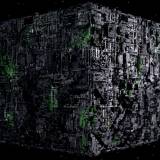All Saturn Games in Order: November 1995 (Part 2)
By borgmaster 3 Comments
An explanation of what I'm doing here can be found in my introduction post.
Last time we looked at the first part of November '95 with Corpse Killer: Graveyard Edition, The Mansion of Hidden Souls, Rayman, Theme Park, NBA Jam: Tournament Edition, and Virtua Cop.
This week we will look at the games released for the Saturn in the third week of November 1995: Dark Legend, Quarterback Attack With Mike Ditka, Sega Rally Championship, Digital Pinball: Last Gladiators, Double Switch, and Ghen War.
----------------------------------------------------------------------------------------------------
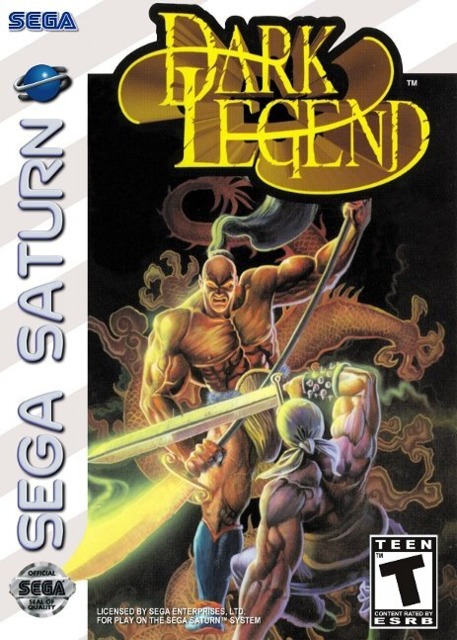
Dark Legend
Release Date: 11/17/1995
Developer: Data East
Publisher: Data East
Time to Needing to Read Water Margin: 40 Minutes
We start off with a highly specific category of game that I am wholly unequipped to address: also-ran 2D fighters from the '90's. Dark Legend (or Outlaws of the Lost Dynasty which is such a better name) is a sprite-based fighting game that is, let's say, inspired by Street Fighter II. It's also somehow based on Water Margin of all things, but I might be getting ahead of myself.
This is a standard package, with an arcade ladder and 2-player modes. There's a dozen characters and about half-a-dozen stages. The characters are differentiated in a way that seems to align with standard fighting game character archetypes, at least as best as I can tell. The character sprites are big and detailed, the animations are smooth, the framerate holds up well enough, the controls are snappy, the environments are nice looking if not particularly detailed, and some of the music slaps. This is by all appearances an entirely competent fighting game of its era.
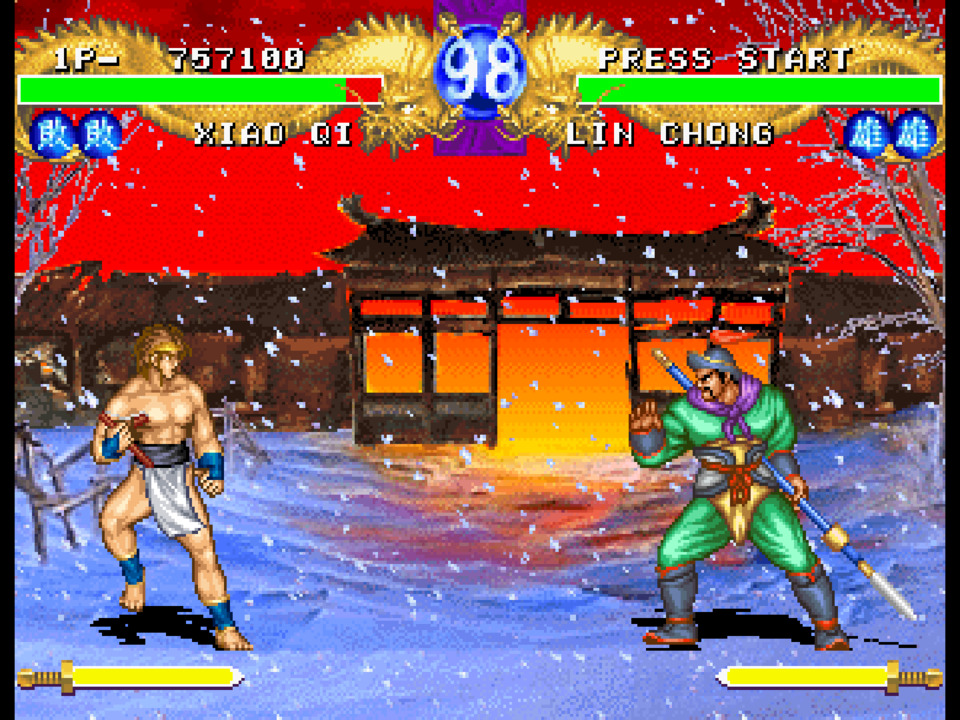
Now, I have nowhere near the expertise to judge the technical quality or balance of the fighting system. In fact, I didn't figure out how to reliably perform a single special move or combo in my one run up the fight ladder. I've played enough fighting games up to this point that I can throw the difficulty down to easy and get through most fight ladders using only decently timed heavy attacks. As such, I picked a random character and got through the 13 fights to an ending. This is why I can say that the boss is neat in that he transforms into a second stage after winning a round against him, and the endings kinda suck. I would say that this thing seems entirely adequate.
And that's the rub, this game is lodged right in-between games like Street Fighter II beforehand and Street Fighter Alpha and Darkstalkers soon afterward. That's just covering the competition from Capcom, when you throw in all the other 2D fighting games and the appetite at the time for polygonal gaming, there's not much going on here that stands out among the crowd. The only differentiator that this one has going for it is that the characters are inspired by the classic Chinese novel Shuǐhǔ zhuàn, or Water Margin. This is one of the four traditional classics, along with Romance of the Three Kingdoms, and it's where the idea of having 108 characters came from. The only other notable thing about this game is that it is apparently a spiritual sequel to Fighters History, post-lawsuit.
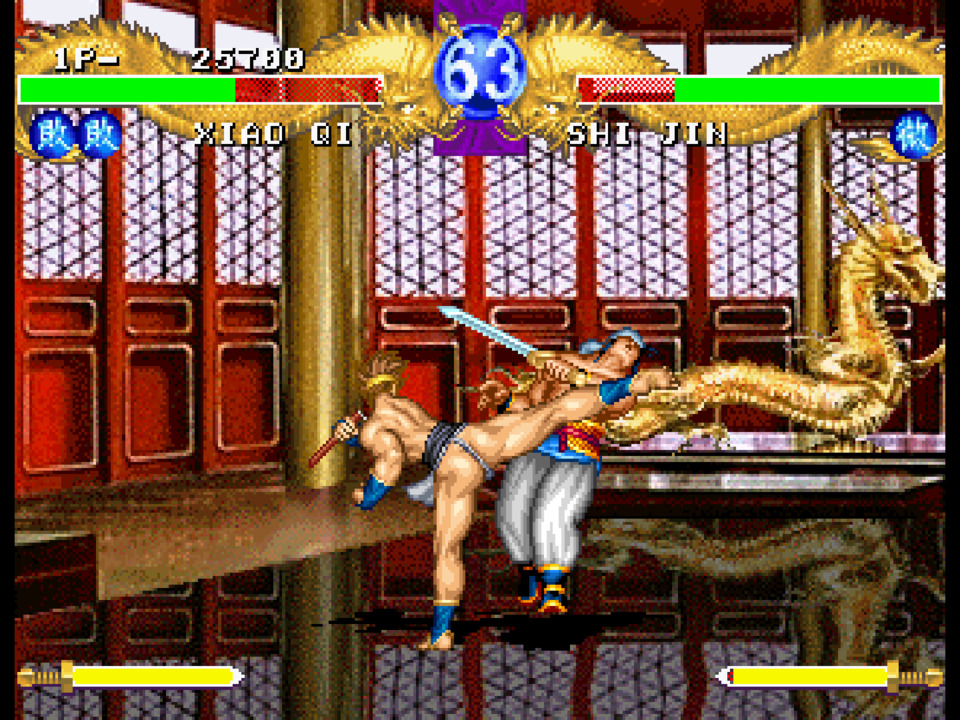
It's crazy to think about how there was such an overflowing market for fighting games in the '90's that something as entirely ok as this game could so thoroughly fall down the memory hole. Oh well, at least this has reminded me that I need to get around to reading Water Margin.
----------------------------------------------------------------------------------------------------
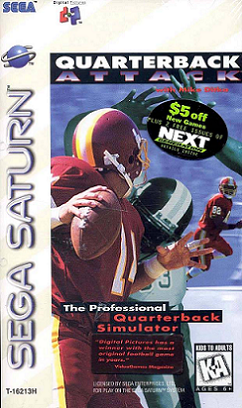
Quarterback Attack with Mike Ditka
Release Date: 11/17/1995
Developer: Digital Pictures
Publisher: Digital Pictures
Time to Getting Sacked Or Something: 15 Minutes
Now we have our second Digital Pictures game of the month, and it's kind of inexplicable. This is an FMV Football game which, instead of being sensible, has the player roleplay as a substitute quarterback who has come in to lead a team in a big game. This match is the only one, and it can be played at full length. I'll try to describe the experience.
The game opens in what looks like a high school Football locker room with the expected Tom Zito opening credits. The eponymous Mike Ditka, who I guess was a famous coach, walks in and tells the team that the starting quarterback has a broken arm and that you, the player, will fill in as a substitute. You get the typical Digital Pictures shit-talking at the camera, and then it's off to the football field. As a note, the football field looks an awful lot like a high school field, and the teams don't have names or mascots. It's wild to watch grown-ass guys in full gear pretend that a game on a small football field is a big thing. The CG crowd inserted into the grandstands only adds to the weird vibes of the thing.
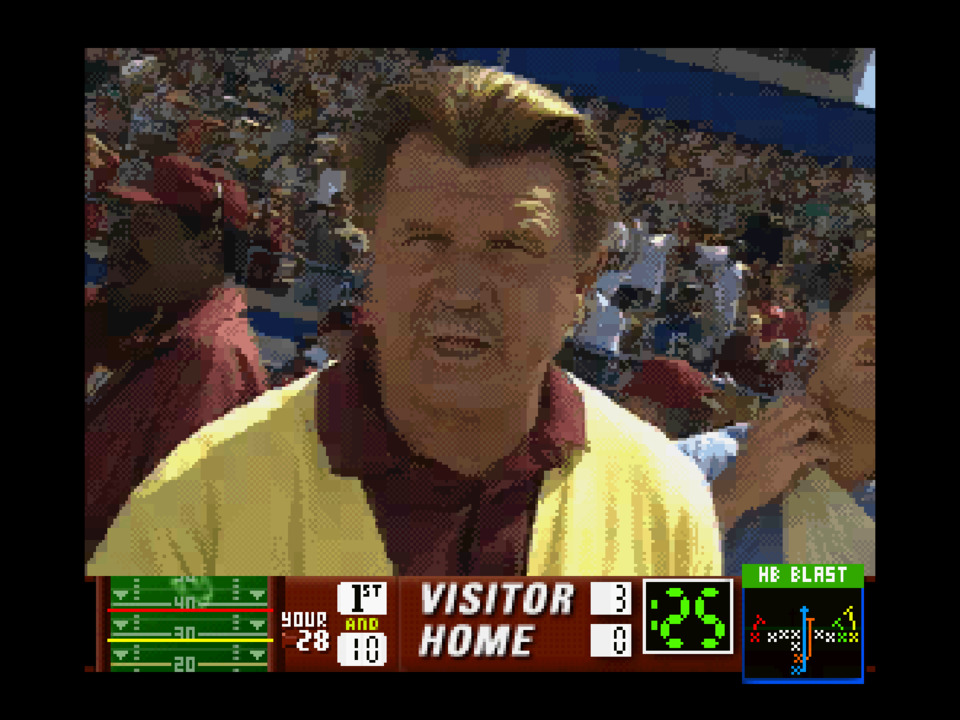
That said, most of the gameplay is from a first-person perspective. That could be novel to someone who is very familiar with the sport, but it's highly disorienting otherwise. The fast camera movements and quick cuts only add to the disorientation. The recognizable part of the gameplay is the screen between plays where you select what you want to do and what plays you want to go for. Of course, I don't know shit about what plays to go for, so I just randomly selected stuff in those screens. After that, you get a first-person hike, and that's when the whole thing falls apart. Neither the passing nor running controls feel good or make sense. To throw, you push a button to look at one of your potential receivers and, I guess, hit the throw button when and if the guy runs into your reticle. I'm guessing at that because I never successfully completed a pass. You can also run with the ball and try your hand at the clumsy dodge controls. It seems that punting or anything else doesn't involve any direct player interaction, so that seems to be it. There is also no defensive gameplay, so you just kinda watch that play out.
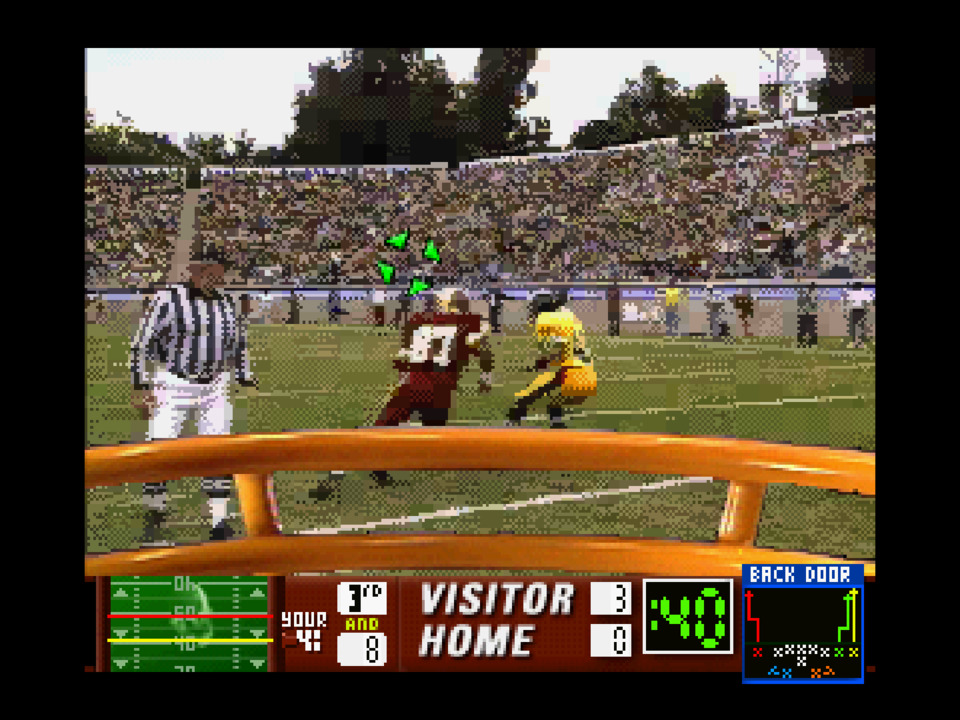
The roleplay nature of the game is abnormal, and the way that it's executed prevents the player from gaining the spatial awareness necessary for that roleplaying to work. Since there aren't other options, you either figure the thing out through trial and error or you set the disc on fire. Obviously, I didn't have the interest or patience to put in the required diligence. Hell, I'd rather play NFL's Greatest: San Francisco vs. Dallas 1978-1993, and yeah, I know that it's barely a video game. The gameplay philosophy in Quarterback Attack seems to be a running theme with Digital Pictures games, though I'll have more to say on that later.
The video quality is as bad as can be expected and the acting, such as there is, is cheesy and amateurish. The Tom Zito branded characters-insulting-the-camera method is more appropriate here than in something like Night Trap, so at least that works. Mike Ditka is obviously playing a heightened version of himself, but I couldn't figure out whether the other players were football guys trying to act or actors trying to play football. With enough budget, they could have had football guys for the game shots and actors for the close-ups. I would be impressed if that's what happened, but I wouldn't be surprised if they got some sub-NFL football players to both play and yell at the camera every now and then.
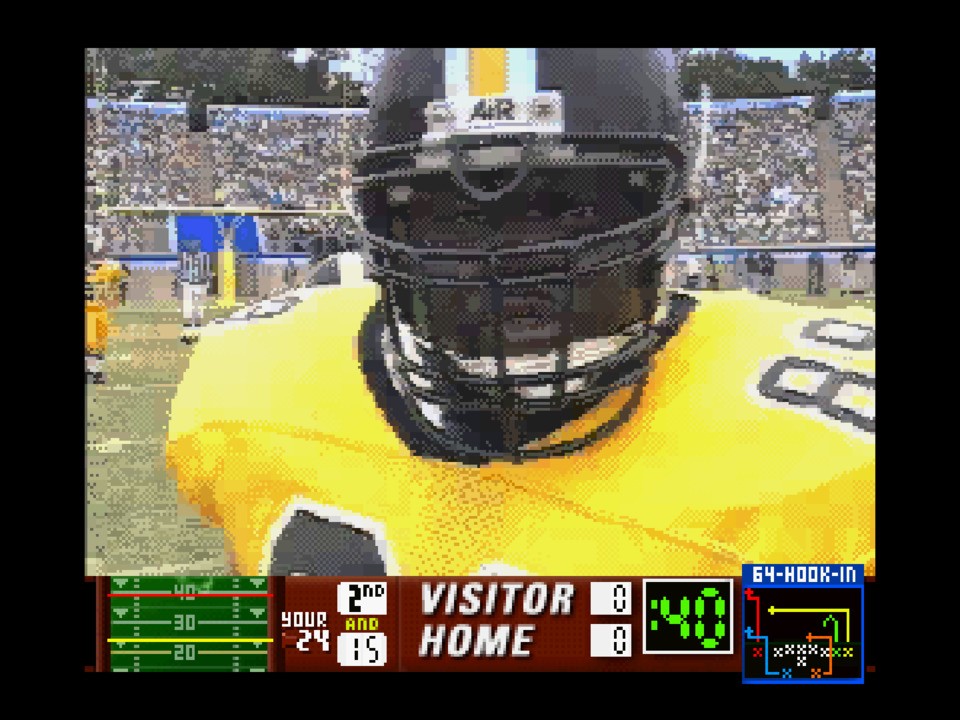
It all comes back to the oddness of the basic concept of this game. It boggles the mind to think of the planning needed to shoot film of various play outcomes during a football game and stitch them all together in a way that is at least a little bit convincing for a video game. I saw a couple of repeated clips in my 15 minutes with the game, but that's actually pretty good considering how fast paced the editing is. This was an ambitious project, made to carry the Digital Pictures style into the new generation, but it fails miserably at the part where you have to play the thing. This is an odd curiosity that should be remembered more than it is.
----------------------------------------------------------------------------------------------------
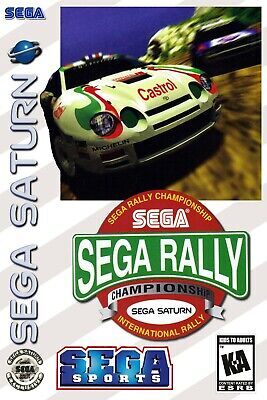
Sega Rally Championship
Release Date: 11/18/1995
Developer: AM3
Publisher: Sega
Time to Game Over Yeeeeaaaah: 28 Minutes
Now onto the next big Sega release of the month. As far as I can tell, this game is the point where the niche Rally Racing sub-genre really got going. Most Rally games beforehand were either scaler-style racing games with dirt roads or esoteric PC games. This is also more than just a reskin of Daytona USA, which it very easily could have been. Let's get into the details.
Sega Rally Championship is structured the same as all the other non-fighting Sega Model 2 games, such as Daytona USA and Virtua Cop, in that you get two options for playable car and three stages organized from Easy to Expert. The first noticeable difference between this and Daytona USA are the basic car tuning options available in this one. I didn't touch those because I straight-up have no idea how that stuff works, but it's good to have it available. There's supposed to be some unique two-player options, but I didn't touch those. For single player, you have the option to practice on each track or go for the titular championship. This strings together the three races, carrying over your ending position between them. The goal is to climb from 15th to 1st across those races; this is a straightforward arcade game.
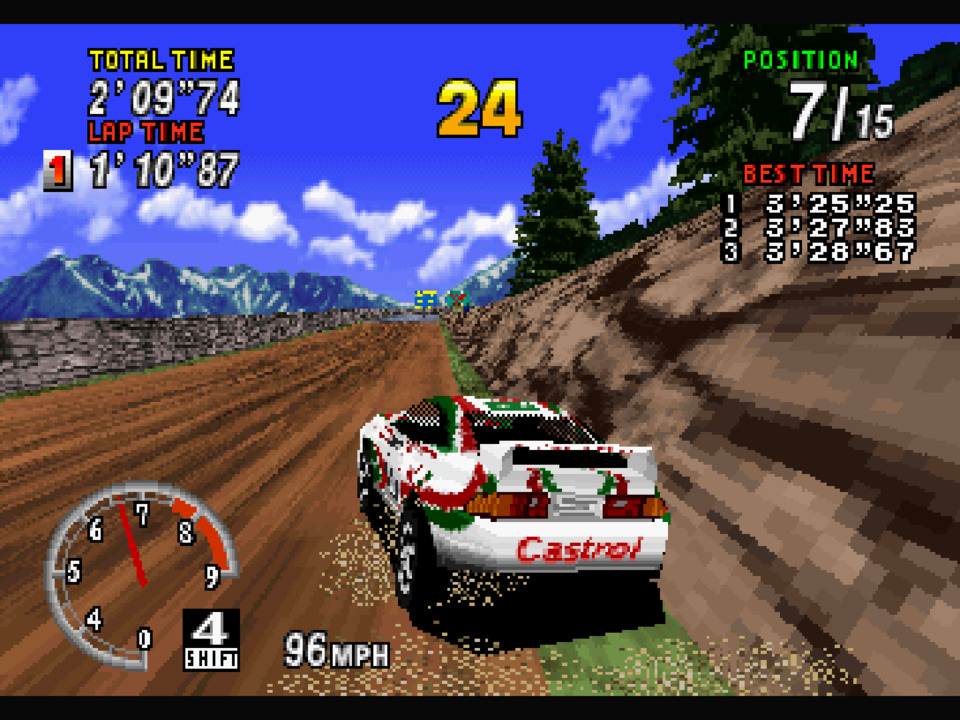
The main selling point appears to have been the somewhat unique driving model. You go between different track surfaces in each race, and the car handling changes based on that. We take that for granted in racing games these days, but it wasn't until this game that the programming for it got figured out to any degree of authenticity. That technical achievement alone makes this thing the most important Rally game ever made, even though it wasn't by any means the first or even the first polygonal Rally game.
Now we come to the 'but'. Being one of the first attempts to accurately model off-road driving, it shouldn't be surprising that the controls in this thing are squirrely as all hell. I only sometimes felt like I had any control over the car during the half-hour I spent with this game. Additionally, being an arcade game, it demands a very high level of proficiency to win the championship. The two attempts I put in resulted in 5th and 4th place finishes. If I put in the time to get a real feel for the handling and memorize the tracks, I could probably eventually win. That's the only way this game could be, considering a person could see all the content in less than 10 minutes. This game runs into the same issue as Ridge Racer or Daytona USA, in that there is just enough going on to draw interest in an arcade setting but nowhere near enough for a home release. I'm inclined to give these games a pass, as polygonal racing is hard, and developers were still figuring it out at the time.
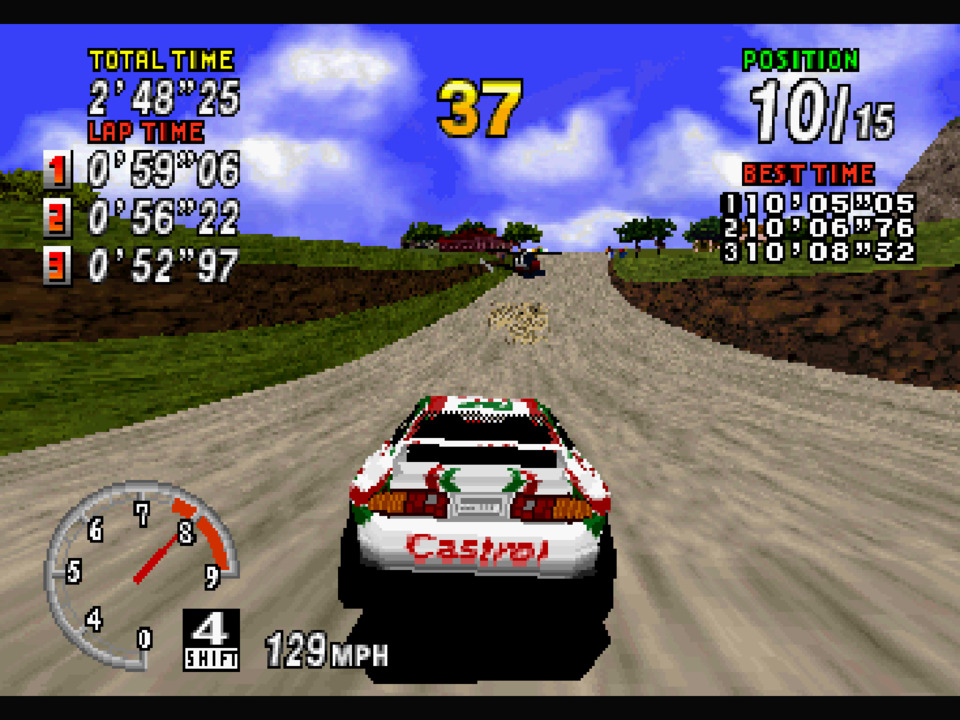
Regarding everything around the gameplay, the graphics are some of the best so far on the Saturn and the sound design is overall good. In fact, this is the first racing game I've seen on this platform where the polygons don't seem angry. Also, the player vehicle is well textured and that helicopter in the first track produces some nice dynamic effects. The music didn't make much of an impression on me, but I love the little vocal sting that goes with the game over screen.
This game also seems to have a bit of a fun lineage with the Sega/Namco arcade war. It seems that the game director for Sega Rally Championship was one of the designers on Ridge Racer who got poached by Sega. I bet there's some interesting stuff in the story of that years-long competition. Someone let me know if there's a book or something. Oh, and Tetsuya Mizuguchi was involved in this game as well; it's weird to think that he was Sega's racing guy in the '90's.
----------------------------------------------------------------------------------------------------
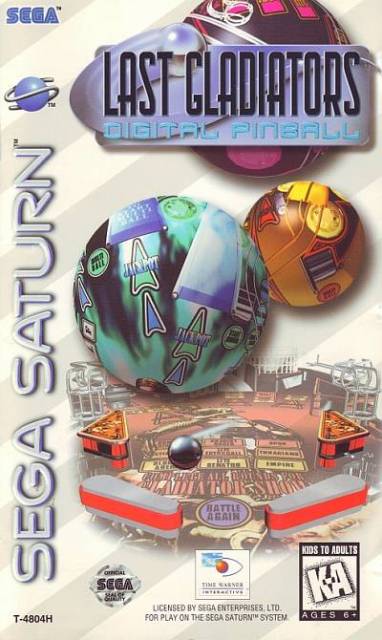
Digital Pinball: Last Gladiators
Release Date: 11/22/1995
Developer: KAZe
Publisher: KAZe
Time to TILT: 23 Minutes
I'm not a fan of pinball. This is mainly because I fail to see the appeal, and secondly because I'm not good at it. I don't have any specific complaints about the pinball generally, but it's easy to find mean-spirited things to say about it when the mood strikes me. That striking usually happens when I must play pinball for more than five minutes in a sitting, which should clue you in to how I feel about this game.
Digital Pinball lives up to its name and goes no further. This is a package of four original digital pinball machines that attempt to capture the design and physics of contemporary machines. This is supposed to provide new and realistic pinball experiences in the comfort of one's home. When a game tries this, it usually means that the experience is not real-world accurate and that the boards are sub-par in design. And because the game even tries to be realistic, it fails to take advantage of the unlimited possibilities inherent to the medium of video games. Games that go down this path thus fail to do anything interesting or worthwhile. Though, I don't know how committed pinheads feel about this kind of thing.
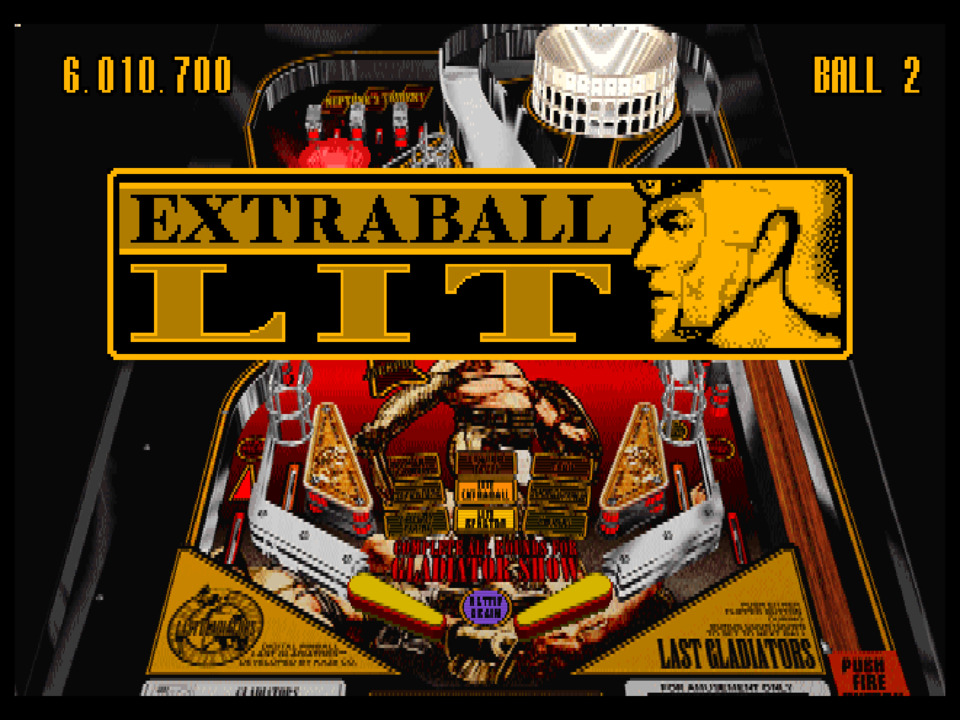
Regardless of how pinball fans feel, this game enthusiastically falls for that classic pinball game blunder. The pinball gameplay makes every attempt to be realistic, and I didn't notice anything off with the ball physics because I lose quickly either way. There is an effort to simulate the kinds of LED monochrome displays that were common on pinball machines, and it seems largely successful at that. Though, the LED display effects pop-up over the middle of the playfield, which caused me to lose track of the ball which is generally not cool. The pattern in my experience with any given board is that I would either lose immediately or last long enough to disassociate from boredom and then lose. That makes this is an accurate pinball experience, though I was able to discern that some of the board designs were better than others. Here are short reviews for each board:
- Gladiators - This is probably the best designed board and the namesake of this package. You can tell that the most thought and effort went into it
- Knight of the Roses - This one is ok, I guess. I almost got the high score on my first play, which I feel kinda good about.
- Dragon Showdown - I don't know enough to put it into words, but this is by far the worst board in the game.
- Warlock - Very blegh, and I didn't like the way that guy looked at me. I would rank it third out of the four.
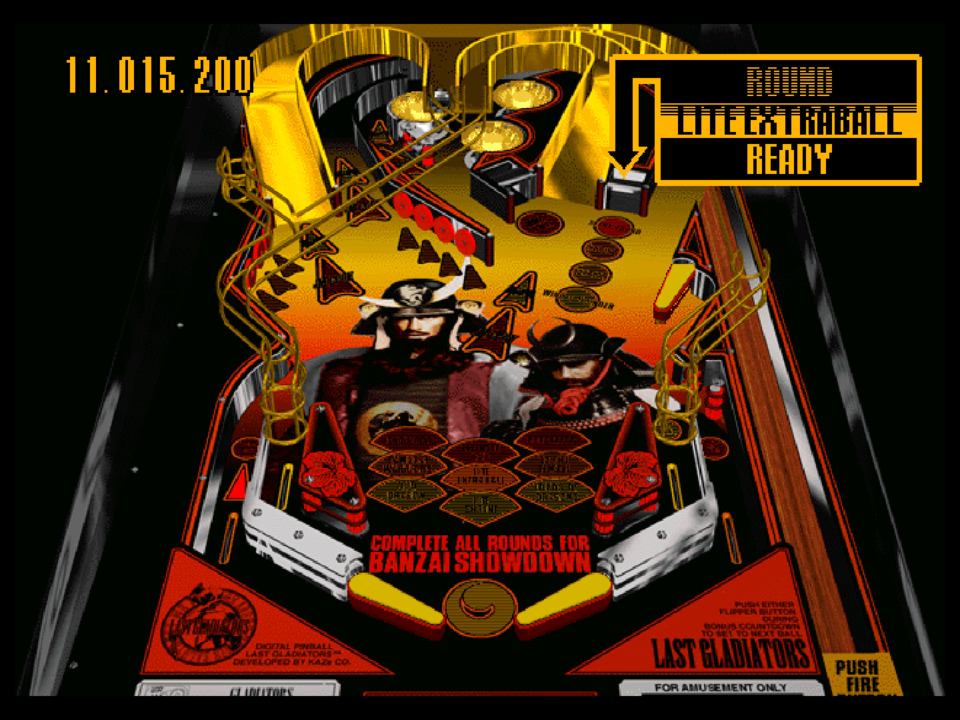
It looks like KAZe took a few more swings at putting pinball games on consoles in the late-90's, so this won't be the last we'll see of this stuff.
----------------------------------------------------------------------------------------------------
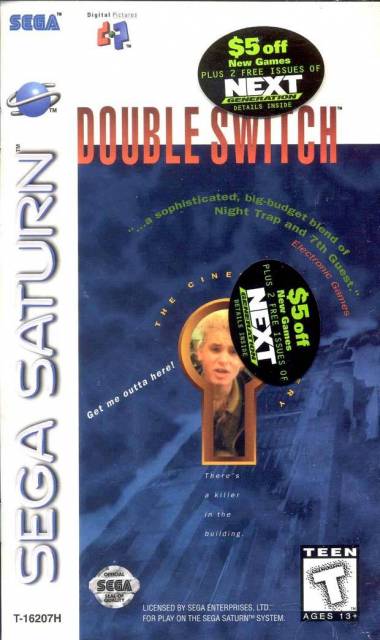
Double Switch
Release Date: 11/22/1995
Developer: Digital Pictures
Publisher: Digital Pictures
Time to I Don't Have The Patience For This: 15 Minutes
Time to Let's Give One More Try: 25 Minutes
I have a hard time judging this game one way or another. There's some stuff to like, a lot to dislike, and a ton that is weird as hell. I really shouldn't have expected anything less than out-of-control nonsense from the spiritual successor to Night Trap, but I did hope for more.
The premise starts off weird and goes progressively off the rails as the story develops. At the start you're immediately thrown into an initial briefing with this guy Eddie, played by Corey Haim well into his downfall, who's locked in the basement of an apartment building that is being invaded by random goons. He needs a four-digit passcode to get out of the basement and the only way to get it is to observe as the random goons occasionally open random control panels. You're also supposed to capture those goons in traps for some reason. Oh, and the whole building is ancient Egypt themed because why not.
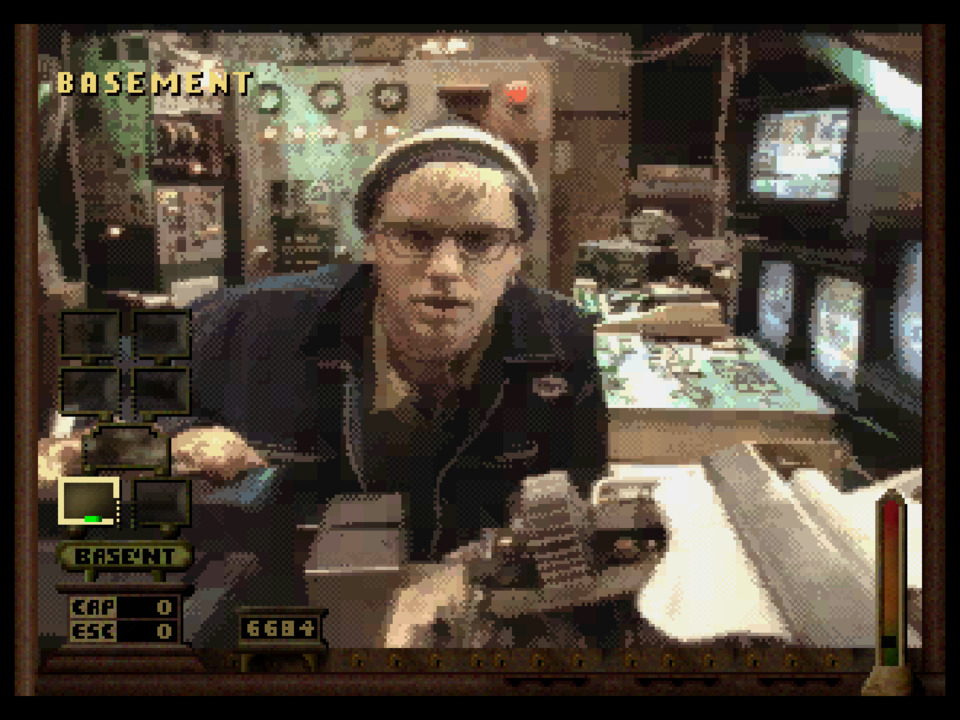
This plays out a lot like Night Trap. You jump between the seven available rooms and activate traps when a bad guy stands in the right spot. The mechanics around this are more involved here than in the previous game. There are multiple traps per room, and they are armed and triggered separately. This requires you to know which traps are where and recognize the visual cues for those traps. This increase in complexity is compounded by the breakneck pace at which you will need to move between rooms and trigger traps. Doing a successful run of Night Trap probably feels like you have to switch around at an unreasonable pace, and Double Switch demands twice the speed. This game is a little under 50% longer and has a total of ~150 enemy appearances compared to the original's ~90 bad guys. Also, this one doesn't have an in-game timer at the bottom, so have fun setting up your own stopwatch when scheduling out the game.
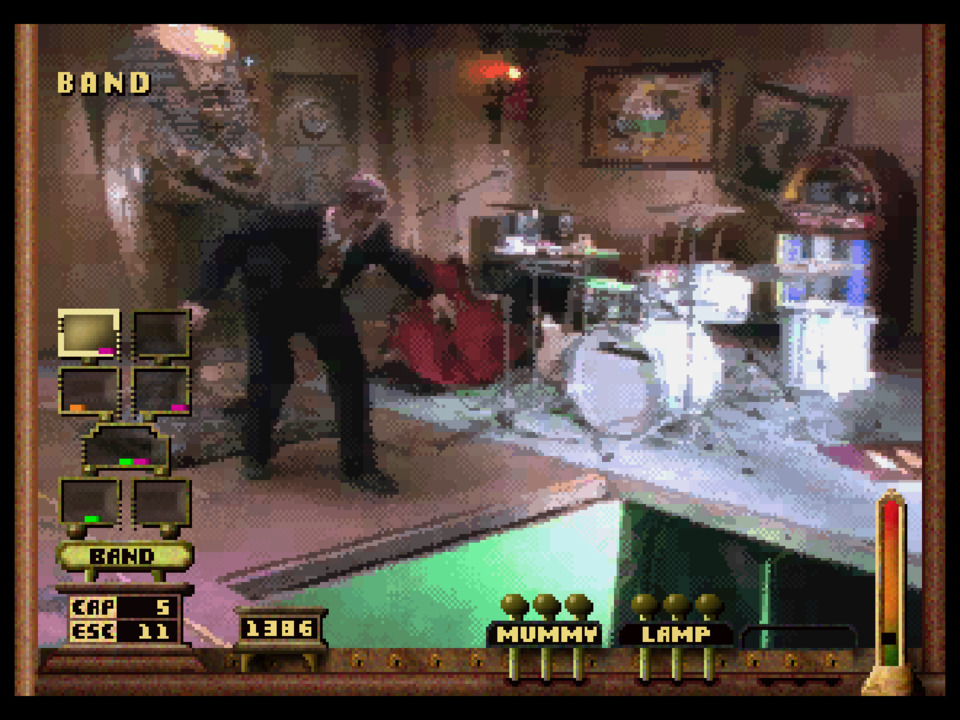
Staying on that, scheduling out the events is the only way to beat either of these games. You can only beat these things by knowing when and where certain events happen, which must be learned wholly by trial-and-error. The decision to take away the UI element that facilitates this process is mean-spirited and baffling. The overall direction of the gameplay changes (upping the tempo, complicating the traps, and reducing the quality-of-life features) was thoroughly wrong-headed and missed the point of the appeal of the first game. I say that because Double Switch maintains and worsens the primary flaw of Night Trap: you can't beat the game and experience the plot at the same time. The developers went through all the effort to write, cast, produce, and shoot all of this footage and the player has to either look away from it or get a game over. Likely, the intention is to have the player see bits and pieces in each run as they're figuring out the right schedule of events, as though the game is a narrative Rogue-Like. If that's the case, then this game moves further away from the correct balance of that design than the first one. Mechanically, this is a sequel that un-improves on the original, which is one of the worst things a piece of media can do.
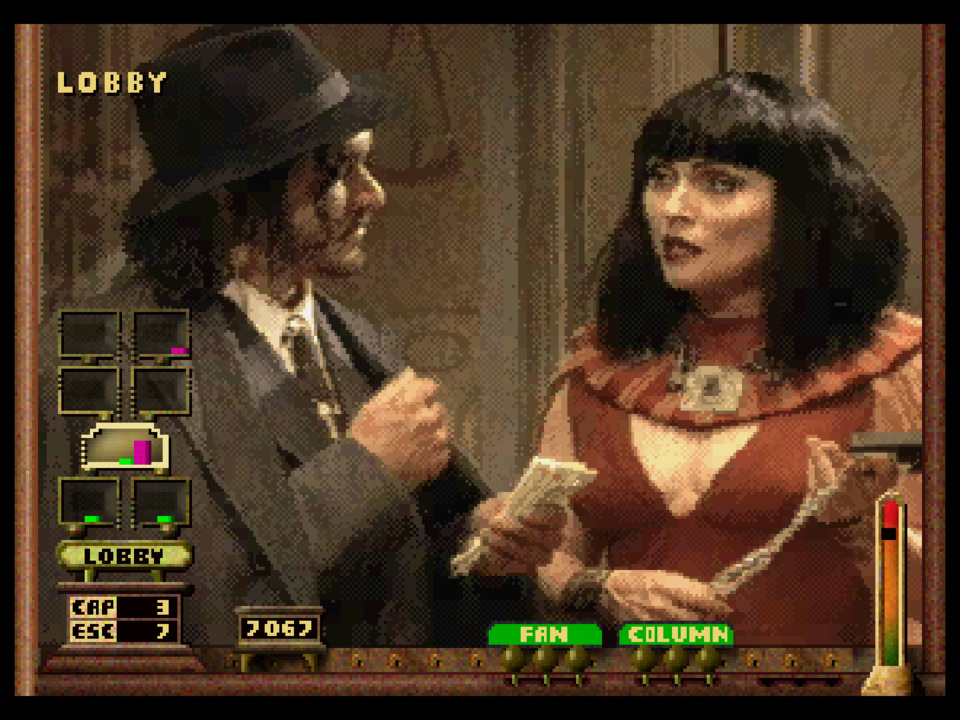
Now, the movie part of this interactive movie is so much weirder and more interesting than what was going on in Night Trap. Not only was Corey Haim slumming it here, but Deborah Harry, R. Lee Ermey, and other discount talent were involved in this farce. The sets are large and laid-out like a Nickelodeon game show, the traps are elaborate, and there is even an attempt at cinematography. There are more sub-plots between characters here than in Night Trap, and this game trades the horror aesthetic for a goofy, PG treasure hunt. The story is broken up into three acts, with the first act ending with Eddie breaking out of the basement and the other ones mainly concerned with trapping him as he attempts to assault the other characters, even though there is nothing menacing about him.
The only good way to interact with this game is to look up a cutscene compilation on YouTube. And that's a shame, because if Tom Zito and friends had developed the usability of this game in the opposite direction from the way they did, they could have preempted Sam Barlow's bullshit by a couple of decades and had more fun with it. This version of Double Switch also bears the ignominious distinction of being Digital Pictures' last major release before going belly up. There will be plenty more games with bad FMV in the mid-to-late-90's (such as the next game), but I consider this to be the inflection point where the industry begins to move away from that nonsense. Maybe that's a sad thing, or maybe we're better off for it. Either way, this silliness was firmly swept into the dustbin of history.
----------------------------------------------------------------------------------------------------
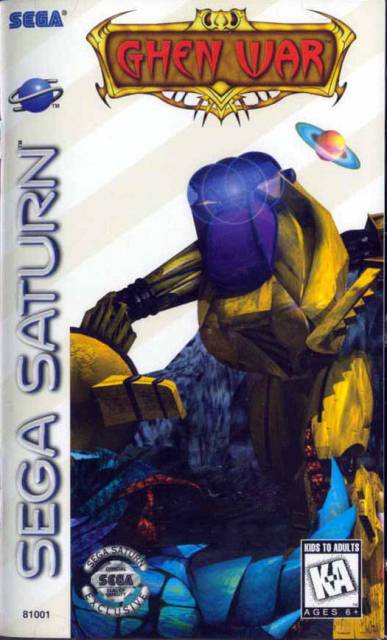
Ghen War
Release Date: 11/22/1995
Developer: Jumpin' Jack Software
Publisher: Sega
Time to Dead On The Moon: 75 Minutes
We end this installment by looking at what is, probably by accident, the second-best console First Person Shooter of 1995.
Ghen War is a mech-based sci-fi shooter, where you wander around open medium-sized levels completing any number of objectives before finding an exit. The levels themselves tend to take place on the surfaces of various planetary bodies across the solar system. The terrain design reminds me a bit of the uncharted planets in Mass Effect, but with bad draw-distance and less maneuverability. There are a handful of alien enemy types to shoot and something like 5-10 poorly differentiated weapons to shoot them with. This game is most notable for having some terrain features that can be dynamically deformed by shooting them, which I guess makes this thing a precursor of the Red Faction games.
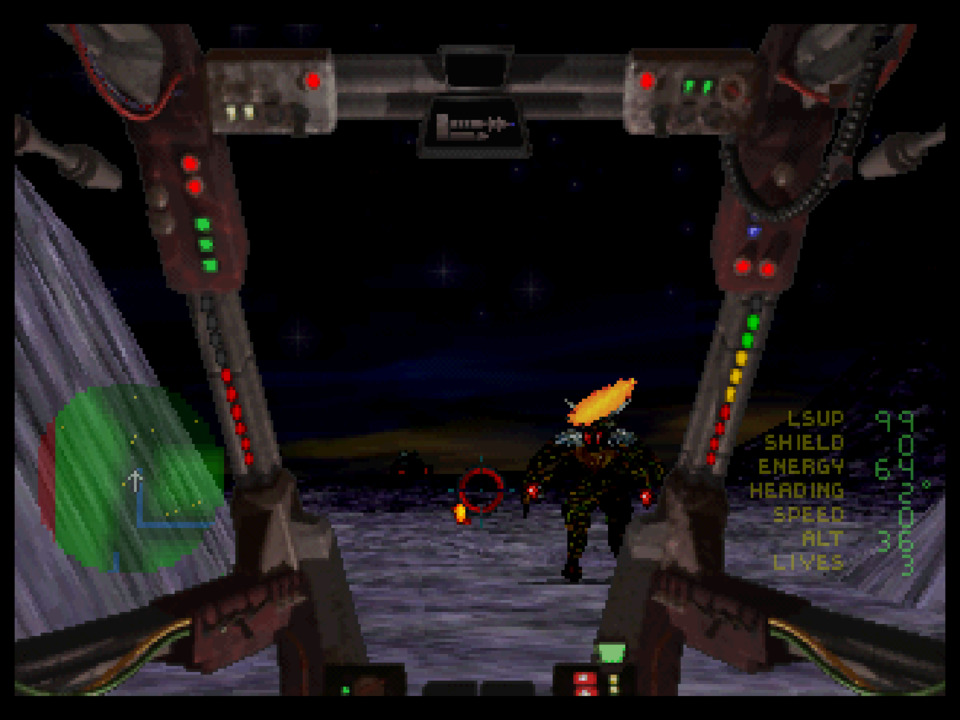
This thing stands out above stuff like Robotica and Kileak (kih-leek) by having a) a detailed plot and b) basically competent level design with a variety of objectives. These positive qualities mostly balance out the fact that playing it feels like ass. The mech, which is totally not ripped off from Aliens, moves at a sedate pace and while there is an ability to look up and down, the cursor moves painfully slow. It's fortunate then, that the AI is as dumb as sack of bricks and will patiently wait for the player to get oriented and shoot them. There's some aim assistance that helps a little, but not enough. Really, the gameplay is competent enough to not be disastrous but not so much as to be fun, which I guess is the definition of mediocrity. Unlike most games that I've covered, I didn't quit because of annoyance, lack of content, or getting kicked out. I quit out of boredom when I was a little under a third of the way through the game. There's no genuine enjoyment like with Doom or rubbernecking opportunities like in Space Griffon, which left me nothing to latch onto.
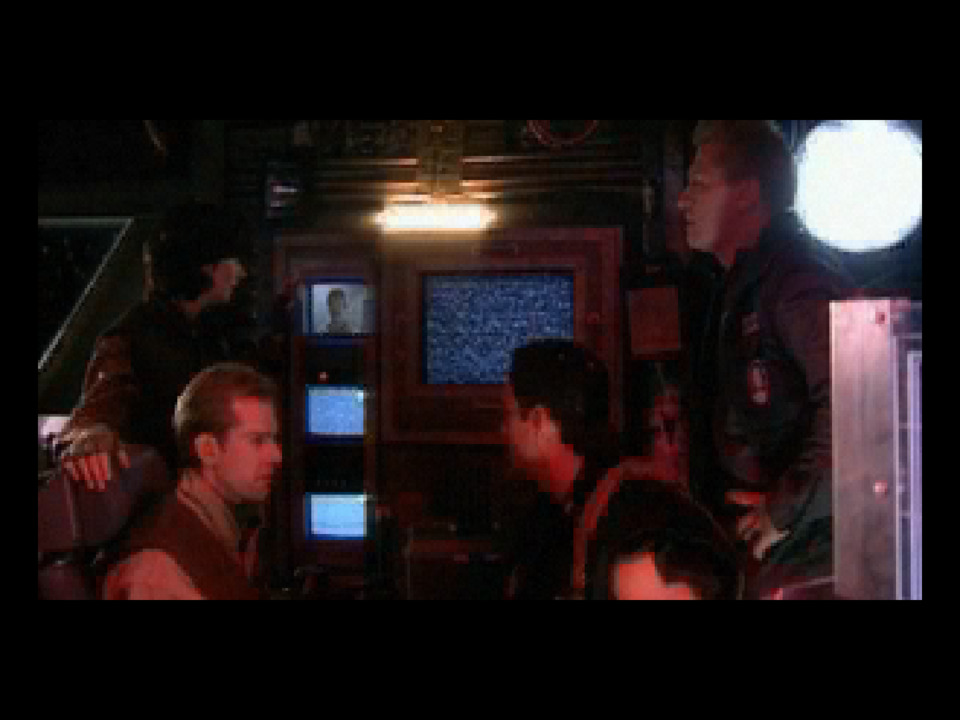
That is not for a lack of trying on the game's part. There is an unnecessary amount of poorly presented world-building and cutscenes with plenty of both cheesy FMV and bad '90's CG. The alien design is bad, the writing is sloppy, and the acting is cliché. The plot follows a small group of space miners who are the sole survivors of the violent betrayal of previously friendly aliens, the titular Ghen, who go on an odyssey to warn and save humanity from the alien threat. Other than the silent protagonist, the crew includes: No-Nonsense Commander, The Dumbass, The Woman, and Dollar Store Lance Henriksen. The acting and production values in the cutscenes are poor, but poor like a failed Sci-fi Channel pilot and not like the kinds of FMV trainwrecks in other games. This is the kind of garbage that I should like, but It wasn't quit incompetent enough to be interesting. The music is also bad but, again, not bad enough to be memorable. It's true when people say that mediocre art is the hardest to criticize.
----------------------------------------------------------------------------------------------------
There's probably something to be said about Digital Pictures' proclivity for grabbing tragic child stars when they were at the end of their careers, but the lives of Corey Haim and Dana Plato are too sad for me to joke about. Regardless, I think I would be comfortable putting Tom Zito alongside Roger Corman and Ed Wood as an all-time shit merchant.
The second week of November '95 has puttered by and I'm not sure whether I'm worse off for having experienced it. Whichever it is, this batch of games need to be slotted into my Ranking of All Saturn Games:
1. Panzer Dragoon
…
3. Sega Rally Championship
11. Dark Legend
14. Ghen War
19. Double Switch
24. Digital Pinball: Last Gladiator
27. Quarterback Attack With Mike Ditka
…
35. The Mansion of Hidden Souls
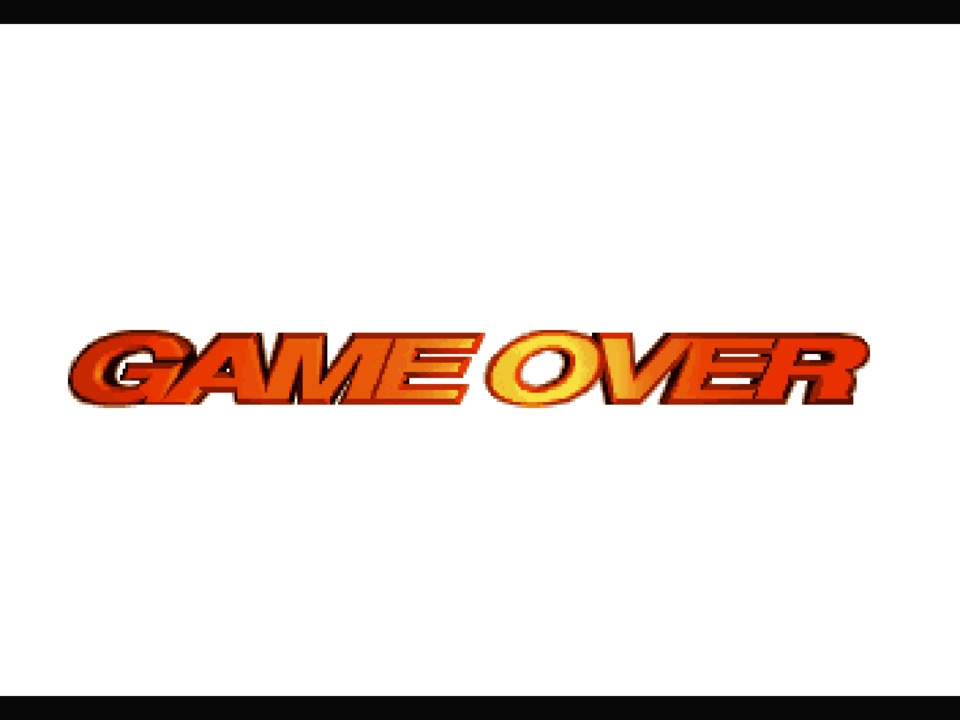
Next time we'll finish out November '95 with: High Velocity: Mountain Racing Challenge, V.R. Virtua Racing, Solar Eclipse, Galactic Attack, and Virtua Fighter 2. It looks like the month is going to cap off with the primary argument Sega had for buying a Saturn.
